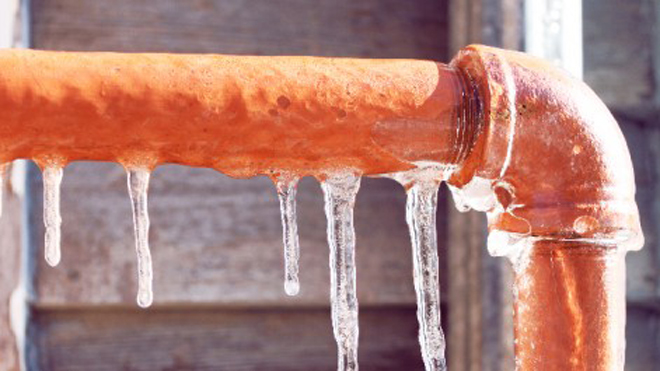Preventing Frozen Plumbing: Effective Strategies for Cold Weather
Preventing Frozen Plumbing: Effective Strategies for Cold Weather
Blog Article
We have found this great article involving Preventing and dealing with frozen pipes below on the internet and thought it made perfect sense to quickly share it with you on this site.

Winter can wreak havoc on your pipes, specifically by freezing pipelines. Below's exactly how to prevent it from happening and what to do if it does.
Intro
As temperature levels decrease, the danger of frozen pipelines boosts, possibly bring about costly fixings and water damage. Comprehending just how to prevent icy pipelines is critical for homeowners in cold environments.
Avoidance Tips
Insulating prone pipelines
Wrap pipes in insulation sleeves or make use of warmth tape to safeguard them from freezing temperature levels. Focus on pipes in unheated or exterior locations of the home.
Heating techniques
Maintain interior areas appropriately heated up, particularly locations with plumbing. Open cupboard doors to permit cozy air to circulate around pipelines under sinks.
Exactly how to identify frozen pipelines
Seek lowered water flow from faucets, unusual odors or sounds from pipes, and visible frost on exposed pipes.
Long-Term Solutions
Structural modifications
Think about rerouting pipelines far from outside walls or unheated locations. Include additional insulation to attics, cellars, and crawl spaces.
Updating insulation
Invest in premium insulation for pipes, attic rooms, and walls. Appropriate insulation aids preserve consistent temperature levels and minimizes the danger of frozen pipes.
Protecting Outside Pipes
Garden hose pipes and exterior taps
Disconnect and drain pipes garden hose pipes before winter. Install frost-proof spigots or cover outside taps with protected caps.
Understanding Icy Pipes
What triggers pipes to freeze?
Pipelines ice up when exposed to temperatures listed below 32 ° F (0 ° C) for prolonged periods. As water inside the pipes freezes, it expands, taxing the pipe walls and possibly creating them to burst.
Dangers and problems
Frozen pipes can bring about water supply disturbances, building damages, and pricey repair work. Ruptured pipes can flooding homes and create extensive structural damages.
Indicators of Frozen Pipeline
Determining frozen pipes early can avoid them from bursting.
What to Do If Your Pipelines Freeze
Immediate activities to take
If you presume icy pipelines, keep faucets open up to relieve stress as the ice thaws. Make use of a hairdryer or towels taken in warm water to thaw pipes slowly.
Conclusion
Stopping icy pipes requires proactive procedures and fast reactions. By recognizing the reasons, indications, and preventive measures, property owners can secure their pipes during winter.
5 Ways to Prevent Frozen Pipes
Drain Outdoor Faucets and Disconnect Hoses
First, close the shut-off valve that controls the flow of water in the pipe to your outdoor faucet. Then, head outside to disconnect and drain your hose and open the outdoor faucet to allow the water to completely drain out of the line. Turn off the faucet when done. Finally, head back to the shut-off valve and drain the remaining water inside the pipe into a bucket or container. Additionally, if you have a home irrigation system, you should consider hiring an expert to clear the system of water each year.
Insulate Pipes
One of the best and most cost-effective methods for preventing frozen water pipes is to wrap your pipes with insulation. This is especially important for areas in your home that aren’t exposed to heat, such as an attic. We suggest using foam sleeves, which can typically be found at your local hardware store.
Keep Heat Running at 65
Your pipes are located inside your walls, and the temperature there is much colder than the rest of the house. To prevent your pipes from freezing, The Insurance Information Institute suggests that you keep your home heated to at least 65 degrees, even when traveling. You may want to invest in smart devices that can keep an eye on the temperature in your home while you’re away.
Leave Water Dripping
Moving water — even a small trickle — can prevent ice from forming inside your pipes. When freezing temps are imminent, start a drip of water from all faucets that serve exposed pipes. Leaving a few faucets running will also help relieve pressure inside the pipes and help prevent a rupture if the water inside freezes.
Open Cupboard Doors
Warm your kitchen and bathroom pipes by opening cupboards and vanities. You should also leave your interior doors ajar to help warm air circulate evenly throughout your home.

I was guided to that write-up on Helpful Tips to Prevent Frozen Pipes this Winter from an acquaintance on a different blog. Please take the opportunity to distribute this blog posting if you enjoyed it. Thanks for being here. Revisit us soon.
Call Report this page